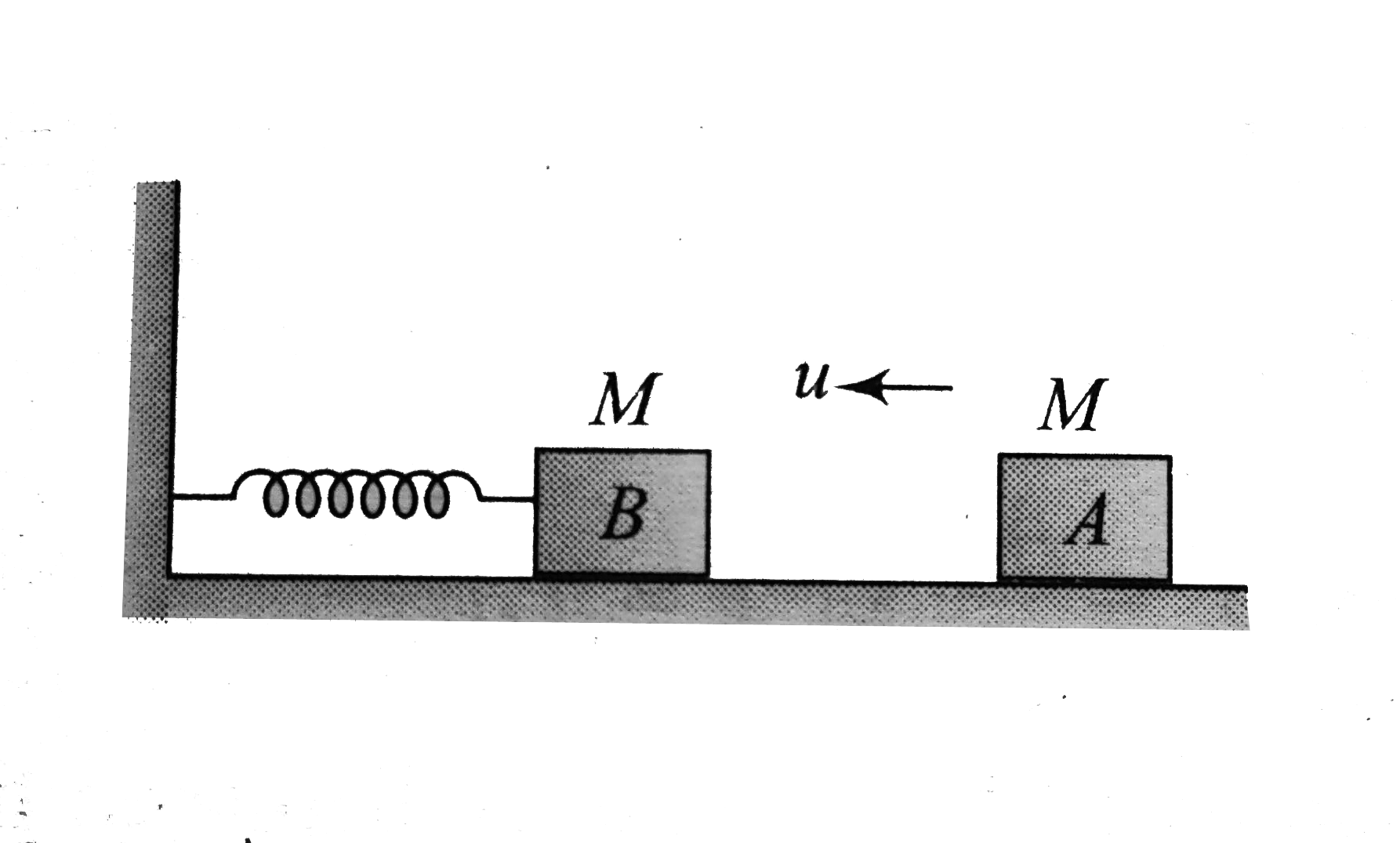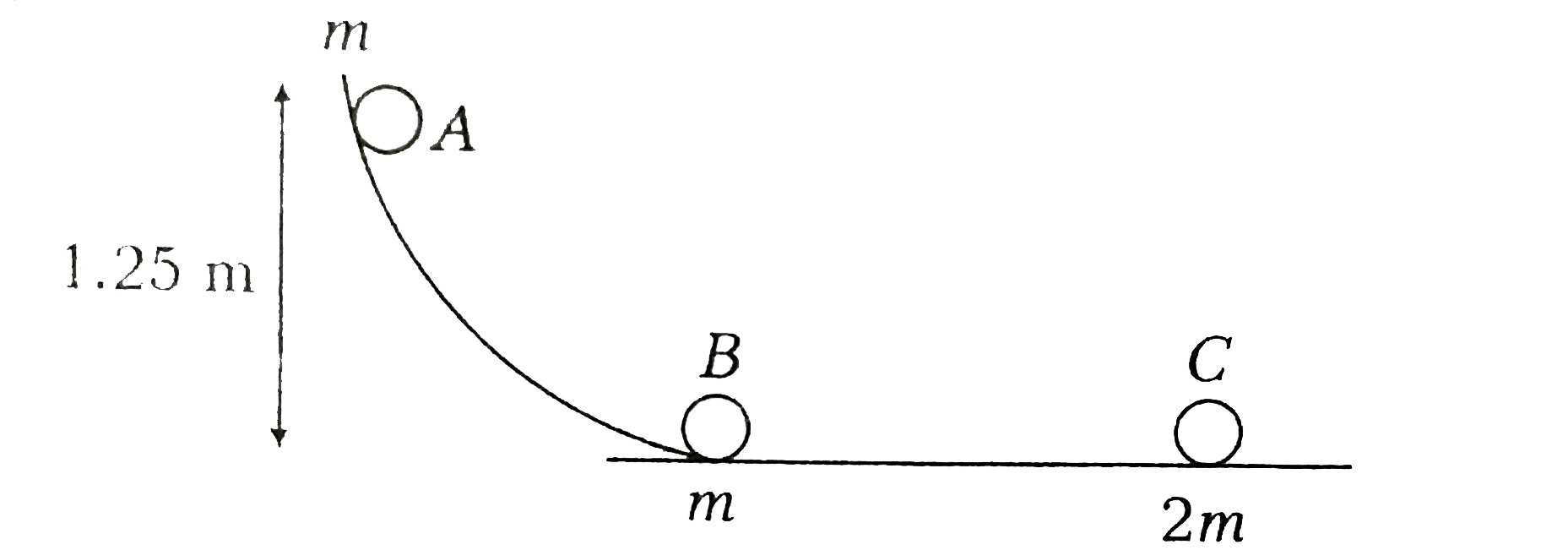Three carts move on a frictionless track with inertias and velocities as shown. The carts collide and stick together after successive collision.
(a) Find loss of mechanical energy when B & C stick together.
(b) Find magnitude of impulse experienced by A when it sticks to combined mass (B & C).

The correct Answer is:(a)3 J, (b) 125N.s

conservation of momentum =1(1)−2(2)=−3v
Loss in energy =[12(1)(1)2+12(2)(2)2]−[12(3)(v)2]
=12+4−32=3J

conservation of momentum =(2)(1)−3(1)=−5v'
v'=15m/s
Impulse on A=2(−15)−2(1)=−125kgm/s.=−125Ns.
Topper's Solved these Questions
- CENTRE OF MASS & MOMENTUM CONSERVATIONBook:BANSALChapter:CENTRE OF MASS & MOMENTUM CONSERVATIONExercise:EXERCISE-4 (SECTION-A) (JEE-ADVANCED Previous Year Questions)
Explore 11 Videos
- CENTRE OF MASS & MOMENTUM CONSERVATIONBook:BANSALChapter:CENTRE OF MASS & MOMENTUM CONSERVATIONExercise:EXERCISE-4 (SECTION-A) (Comprehension)
Explore 3 Videos
- CENTRE OF MASS & MOMENTUM CONSERVATIONBook:BANSALChapter:CENTRE OF MASS & MOMENTUM CONSERVATIONExercise:EXERCISE-2[MATRIX TYPE]
Explore 2 Videos
- GRAVITATIONBook:BANSALChapter:GRAVITATIONExercise:EXERCISE -4 Section - B
Explore 6 Videos
Similar Questions
Two balls each of mass 0.25kg are moving towards each other in a straight line,one at 3m/s the other at 1m/s collide.The balls stick together after the collision.The magnitude of the final velocity of the combined mass in ms−1 is?
View SolutionIn the figure shown, the block A of mass m collides with the identical block B and after collision they stick together. Calculate the amplitude of resulatant vibration.

View Solution
Knowledge Check
Three carts move on a frictionless track with masses and velocities as shown. The carts collide and stick together after successive collisions. Find the total magnitude of the impulse experience by A.
m1=3kg,m2=1kg,m3=2kg
v1=1m/s,v2=1m/s,v3=2m/s→+ve
 A1NsB2NsC3NsD4Ns
A1NsB2NsC3NsD4NsA body of mass 4kg moving with velocity 12m/s collides with another body of mass 6kg at rest. If two bodies stick together after collision , then the loss of kinetic energy of system is
AzeroB288JC172.8JD144JTwo masses of 0.25 kg each moves toward each other with speed 3 ms−1 collide and stick together. Find the final velocity
A0.5ms−1B2ms−1C1ms−1D0.25ms−1
Suppose the particle of the previous problem has a mass m and a speed v before the collision and it sticks to the rod after the collision. The rod has a mass M. a. Find the velocity of the particle with respect to C of the system consituting the rod plus the particle. b. Find the velociyt of the particle with respect to C before the collision. c. Find the velocity of the rod with respect to C before the colision. e. find the moment of inertia of the system about the vertical axis through the centre of mass C after the collision. f. Find the velociyt of the centre of mass C and the angular velocity of the system about the centre of mass after the collision.
View SolutionA body of mass a moving with a velocity b strikes a body of mass c and gets embered into it. The velocity of the systems after collision is
View SolutionA particle A of mass m initially at rest slides down a height of 1.25 m on a frictionless ramp, collides with and sticks to an identical particles B of mass m at rest as shown in the figure.

Then, particles A and B together collide elastically with particle G of mass 2m at rest. The speed of particle G after the collision with combined body (A+B) would be (Take, g=10ms−2)
View SolutionA particle of mass m with an initial velocity uˆi+2uˆj collides with a particle of mass 3m at rest. After collision, the two particles stick together and the combined particle moves with a velocity vˆi+v'ˆj. Which of the following is incorrect?
View SolutionA bullet of mass A and velocity B is fried into a block of mass C and sticks to it. The final velocity of the system equals
View Solution

